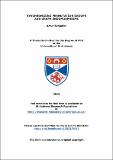Synchronizing permutation groups and graph endomorphisms
Abstract
The current thesis is focused on synchronizing permutation groups and on graph endo-
morphisms. Applying the implicit classification of rank 3 groups, we provide a bound
on synchronizing ranks of rank 3 groups, at first. Then, we determine the singular graph
endomorphisms of the Hamming graph and related graphs, count Latin hypercuboids of
class r, establish their relation to mixed MDS codes, investigate G-decompositions of
(non)-synchronizing semigroups, and analyse the kernel graph construction used in the
theorem of Cameron and Kazanidis which identifies non-synchronizing transformations
with graph endomorphisms [20].
The contribution lies in the following points:
1. A bound on synchronizing ranks of groups of permutation rank 3 is given, and a
complete list of small non-synchronizing groups of permutation rank 3 is provided
(see Chapter 3).
2. The singular endomorphisms of the Hamming graph and some related graphs are
characterised (see Chapter 5).
3. A theorem on the extension of partial Latin hypercuboids is given, Latin hyper-
cuboids for small values are counted, and their correspondence to mixed MDS
codes is unveiled (see Chapter 6).
4. The research on normalizing groups from [3] is extended to semigroups of the
form <G, T>, and decomposition properties of non-synchronizing semigroups are described which are then applied to semigroups induced by combinatorial tiling
problems (see Chapter 7).
5. At last, it is shown that all rank 3 graphs admitting singular endomorphisms are
hulls and it is conjectured that a hull on n vertices has minimal generating set of at
most n generators (see Chapter 8).
Type
Thesis, PhD Doctor of Philosophy
Collections
Items in the St Andrews Research Repository are protected by copyright, with all rights reserved, unless otherwise indicated.

